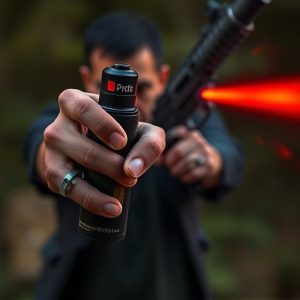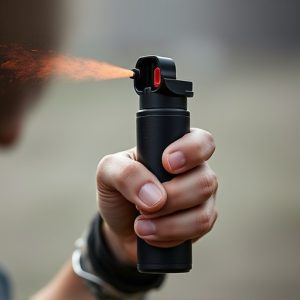Concealed Pepper Spray: Legal, Effective Carrying Techniques for Law Enforcement
Concealed pepper spray is a powerful tool for law enforcement in civil unrest, but its usage is stri…….
Concealed pepper spray is a powerful tool for law enforcement in civil unrest, but its usage is strictly regulated. Officers undergo specialized training in carrying techniques to ensure swift and accurate deployment while minimizing civilian exposure. Protocols cover storage, container selection, and distribution, enhancing operational readiness during dynamic events. Legal framework includes jurisdiction-specific regulations, use-of-force guidelines, and training mandates, balancing law enforcement needs with citizens' rights. Effective carrying techniques, from belt-mounted holsters to wrist/ankle options, ensure quick access for precise deployment during high-pressure situations, contributing to professional riot control responses.
Riot control agents, particularly concealed pepper spray, have become indispensable tools in law enforcement arsenal. This article delves into the legal perspective of these powerful substances, exploring their effectiveness and the strategic carrying techniques for optimal deployment. We examine the rise of concealed pepper spray, its legal implications, and the stringent regulations governing its use. Additionally, we highlight the critical importance of training and safety measures to ensure responsible and accountable handling by law enforcement officers.
- Understanding Riot Control Agents: A Legal Perspective
- Concealed Pepper Spray: The Weapon of Choice
- Carrying Techniques for Optimal Effectiveness
- Legal Implications and Regulations for Law Enforcement
- Training and Safety Measures for Responsible Use
Understanding Riot Control Agents: A Legal Perspective
Riot control agents, including concealed pepper spray, are powerful tools in law enforcement’s arsenal for managing civil unrest and maintaining public safety. From a legal standpoint, the use of such agents is tightly regulated to ensure they’re employed responsibly and proportionately. Law enforcement agencies must adhere to strict protocols governing when, where, and how these substances can be deployed, with special consideration given to concealed carrying techniques.
Officers are trained in various methods for safely and legally carrying pepper spray, focusing on minimizing risks to bystanders and suspects alike. Understanding the legal framework surrounding riot control agents involves delving into specific regulations, training requirements, and use-of-force guidelines that vary across jurisdictions. This ensures a balance between officers’ need for effective tools to control chaos and citizens’ rights to safety and freedom from unreasonable force.
Concealed Pepper Spray: The Weapon of Choice
In the arsenal of riot control agents, concealed pepper spray has emerged as a powerful tool for law enforcement agencies worldwide. Its effectiveness in neutralizing rioters and maintaining public safety makes it the weapon of choice in many high-risk situations. Pepper spray, when used correctly, can disable an individual without causing permanent harm, making it a less lethal option compared to other force methods. The strategic deployment and handling of this agent require specialized training for officers, focusing on concealed carrying techniques that ensure officer safety and minimize civilian exposure.
Carrying concealed pepper spray involves efficient distribution among patrol teams, with each officer equipped to deploy it swiftly and accurately. Law enforcement agencies implement rigorous protocols for its storage, ensuring secure locations within reach for all personnel. The selection of appropriate containers, including specialized holsters or pockets designed for concealment, is crucial in facilitating quick access during dynamic operations. Effective concealed pepper spray carrying techniques not only enhance officer capability but also contribute to the overall safety and professionalism of law enforcement responses to civil unrest and high-intensity incidents.
Carrying Techniques for Optimal Effectiveness
In riot control situations, law enforcement officers must be equipped with effective tools, and one such crucial device is concealed pepper spray. The carrying techniques for this agent play a vital role in its optimal effectiveness. Officers often employ specialized holsters or pouches designed to securely hold the spray while ensuring quick access during high-pressure events. These concealed pepper spray carrying techniques enable officers to deploy the agent precisely when needed, maximizing its impact on controlling riots and minimizing harm to both officers and civilians.
The choice of carrying method depends on various factors, including the type of pepper spray, officer preferences, and operational requirements. Some techniques involve wearing the spray on a belt or in a vest pocket, while others utilize wrist or ankle holsters for quicker deployment. The goal is to strike a balance between ease of use and security, allowing officers to respond swiftly while maintaining control over their equipment during intense riot situations.
Legal Implications and Regulations for Law Enforcement
In many jurisdictions, law enforcement officers are permitted to carry and use riot control agents, including concealed pepper spray, as a means of self-defense and crowd control. However, this power comes with significant legal implications and regulatory constraints. The specific rules vary by country and even within regions, dictating when and how these agents can be deployed. For instance, officers must adhere to strict guidelines on reasonable force, ensuring that the use of riot control agents is proportionate to the threat posed. Non-compliance can lead to legal repercussions, including charges of excessive force or misconduct.
Legal frameworks often mandate training and certification for officers in concealed pepper spray carrying techniques, proper usage, and de-escalation strategies. These regulations aim to ensure that law enforcement uses these powerful tools responsibly, balancing public safety with individual rights. Moreover, transparency and accountability mechanisms are crucial, allowing for independent reviews of incidents involving riot control agents to maintain public trust.
Training and Safety Measures for Responsible Use
Law enforcement agencies worldwide increasingly rely on riot control agents, such as pepper spray, to manage civil disturbances and maintain public safety. However, with great power comes great responsibility. Proper training and safety measures are paramount to ensure that officers use these agents responsibly and effectively. Officers must learn not only the technical aspects of deploying riot control agents but also de-escalation tactics, crowd dynamics, and the legal implications surrounding their use.
Training programs should cover concealed pepper spray carrying techniques, emphasizing discreet deployment while minimizing the risk of injury to bystanders. This includes practicing proper aiming, distance, and force levels tailored to different scenarios. Realistic simulations and scenario-based training allow officers to hone their skills in controlled environments before confronting high-pressure situations. Regular refresher courses are also crucial to keep officers up-to-date with best practices and evolving regulations surrounding the use of riot control agents.
In conclusion, riot control agents, particularly concealed pepper spray, have become indispensable tools in law enforcement’s arsenal. Understanding their legal implications and proper carrying techniques is paramount for ensuring their effectiveness and safety. As these substances carry significant force, rigorous training and adherence to regulations are essential to maintain public trust and protect both officers and citizens. By adopting best practices, law enforcement agencies can maximize the benefits of concealed pepper spray while mitigating potential risks.


